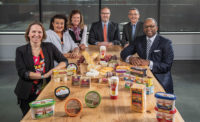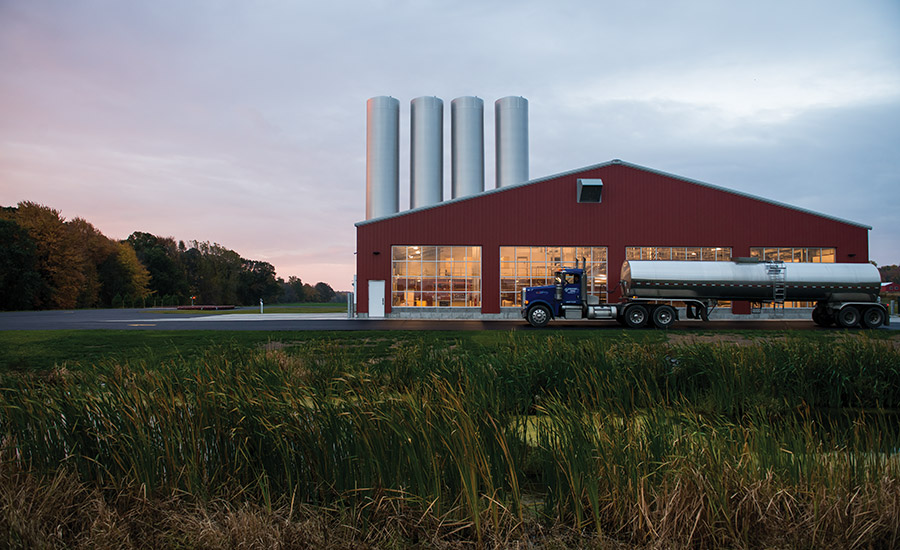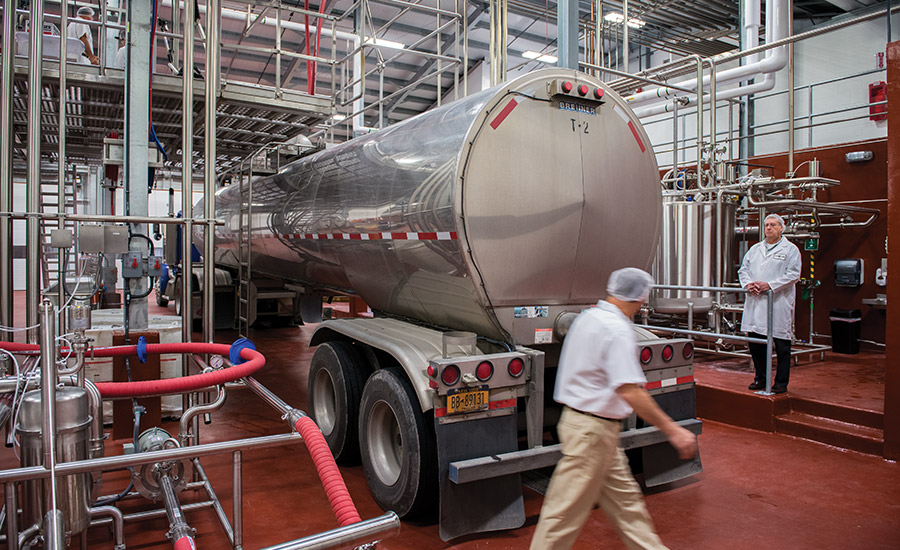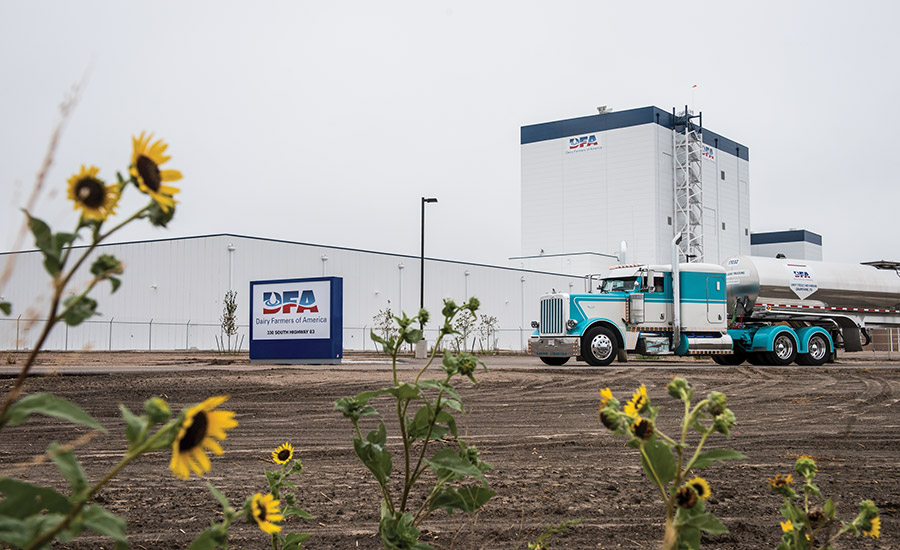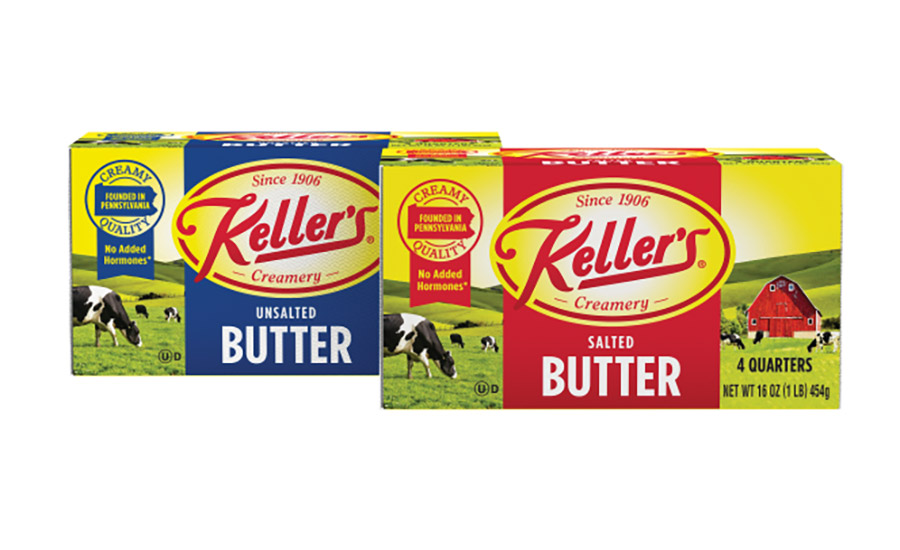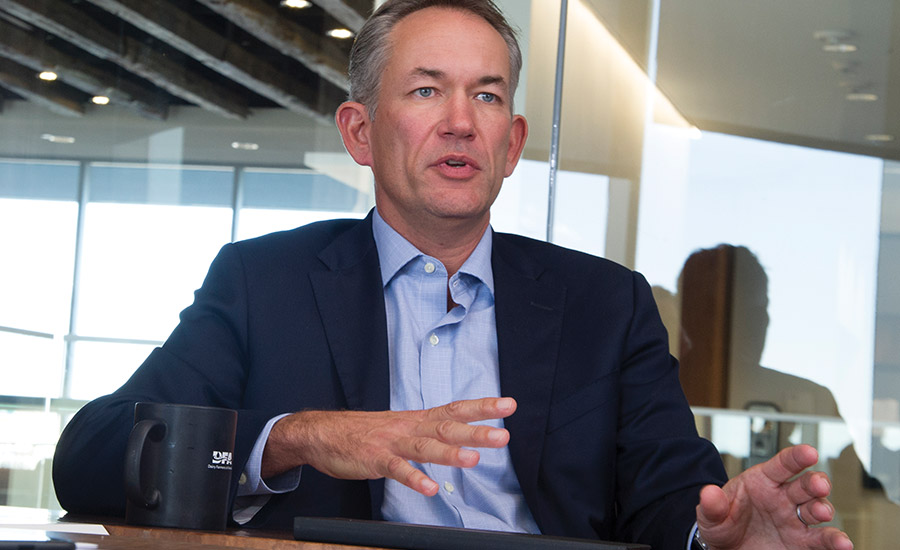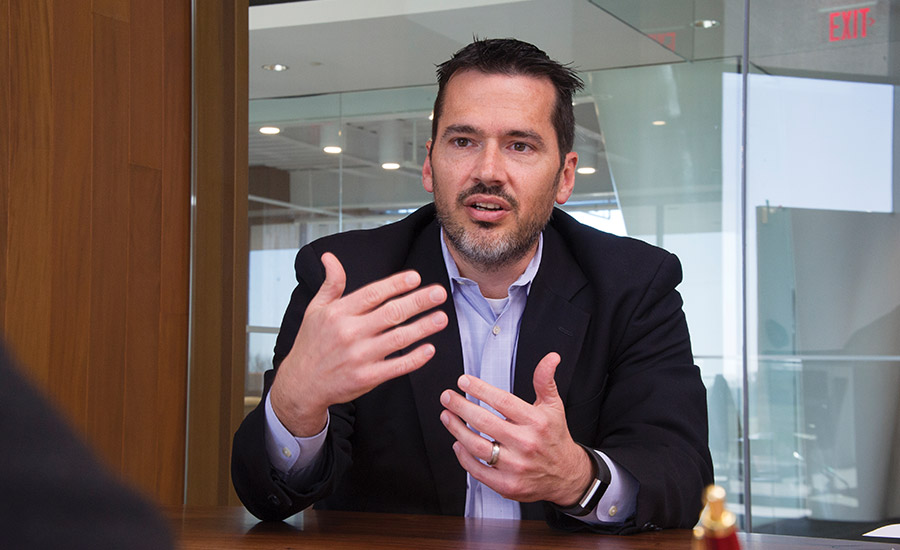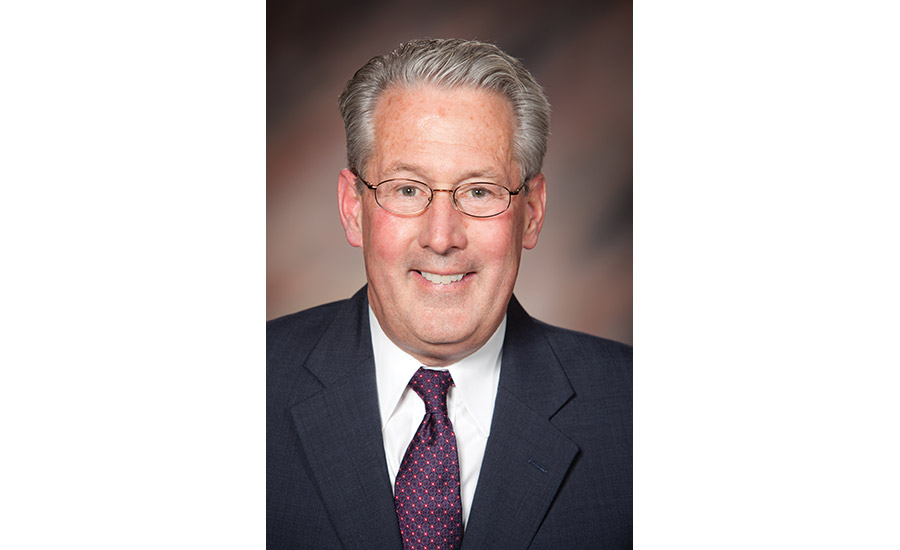Dairy Farmers of America takes 2017 Dairy Processor of the Year honors
Honored for its investments in the dairy industry, strategic partnerships, product innovation and commitment to sustainable dairy processing

Enjoying a milk toast in front of the milk pour sculpture near the entrance of Dairy Farmers of America’s new headquarters building are (l to r) Monica Massey, senior vice president and chief of staff; Pat Panko, senior vice president and chief operating officer, fluid milk and ice cream; Doug Glade, executive vice president of commercial operations; and Ed Tilley, senior vice president and chief operating officer, Beverage and Dairy Foods division.

Constructed on an actual dairy farm and built in partnership with eight local farm families, DFA’s Craigs Station Creamery in Livingston County, N.Y., is a showcase for sustainability and social responsibility.

Constructed on an actual dairy farm and built in partnership with eight local farm families, DFA’s Craigs Station Creamery in Livingston County, N.Y., is a showcase for sustainability and social responsibility.

DFA’s Garden City, Kan., facility is a partnership between DFA and a dozen of its member farms in Kansas; it produces highquality international-grade products such as whole milk powder and skim milk powder.

In addition to addressing white space opportunities, DFA’s product innovation efforts include a focus on new product formats and refreshes to the look of legacy brands.

In addition to addressing white space opportunities, DFA’s product innovation efforts include a focus on new product formats and refreshes to the look of legacy brands.

In addition to addressing white space opportunities, DFA’s product innovation efforts include a focus on new product formats and refreshes to the look of legacy brands.

DFA doesn’t want to make shortterm decisions, noted Pat Panko, senior vice president and chief operating officer, fluid milk and ice cream.

Doug Glade, executive vice president of commercial operations, said DFA’s planned office in Singapore is “an exciting milestone” for the company.

Partnerships aimed at enhancing sustainability at the farm level are a priority, said David Darr, DFA’s president, farm services, and vice president, sustainability and member services.

President and CEO Rick Smith said DFA employees continue to be inspired by the cooperative’s family farmers — and their authenticity and commitment to a long-term relationship.











For Dairy Farmers of America (DFA), the definition of success is simple. It means delivering value back to its 13,000-plus dairy farmer owners and adding value to the marketplace by increasing demand for U.S. dairy products.
But fulfilling that two-pronged mission isn’t so simple. It requires substantial investments in — and commitments to — infrastructure, employees, product innovation and strategic partnerships. Fortunately for DFA’s farmer owners and the greater dairy industry, the Kansas City, Kan.-based cooperative has not held back when it comes to making those investments and commitments.
Adding, revamping facilities


Constructed on an actual dairy farm and built in partnership with eight local farm families, DFA’s Craigs Station Creamery in Livingston County, N.Y., is a showcase for sustainability and social responsibility.
Indeed, DFA’s story of growth is impressive. The cooperative got its start 20 years ago when four regional milk cooperatives — Associated Milk Producers Inc., Mid-America Dairymen Inc., Milk Marketing Inc. and Western Dairymen Cooperative Inc. joined forces. DFA now boasts more than 6,000 employees and 40-plus dairy processing facilities, and it has investments in 35 other facilities.
And the cooperative regularly adds and revamps facilities in its quest to stay true to its mission. One such facility, opened in September, is in Garden City, Kan. A partnership between DFA and a dozen of its member farms in Kansas, it’s the first of its kind and scale in the United States, explained Doug Glade, DFA’s executive vice president of commercial operations.
“The southwest Kansas area continues to be a growing milk supply, and so having a milk processing facility in that area absolutely delivers value back to our farmer owners there,” he said. “But more and more, we’re looking to deliver value to the marketplace by taking milk powders into the global landscape. So that’s a facility that’s really targeted to meeting high-quality international-grade global standards of products like whole milk powder, skim milk powder and more.”

DFA’s Garden City, Kan., facility is a partnership between DFA and a dozen of its member farms in Kansas; it produces highquality international-grade products such as whole milk powder and skim milk powder.
This year DFA also expanded its dairy processing facility in Cabool, Mo., said Ed Tilley, senior vice president and chief operating officer, Beverage and Dairy Foods division. The investment, which included the addition of a bottling line, is part of one of the cooperative’s strategic partnerships.
And DFA is in the midst of a major expansion to its plant in Frederick, Md. The Dairy Maid Dairy facility, which processes milk and juice, needs additional capacity to keep up with consumer demand, said Pat Panko, senior vice president and chief operating officer, fluid milk and ice cream.
“It’s exciting,” he said, adding that DFA invests significantly to bring many other dated facilities up to DFA standards. “It’s just very challenging, these land-locked facilities. It’s not as easy as just building things from scratch — you have to get creative.”
But perhaps the most unique news on the dairy plant front is Craigs Station Creamery, which opened in Livingston County, N.Y., in 2014. Constructed on an actual dairy farm, the facility “is truly a showcase story for traceability, sustainability and environmental responsibility,” said Rick Smith, DFA’s president and CEO, on the occasion of the plant’s first anniversary.
Built in partnership with eight local farm families, the dairy ingredients plant employs several environmentally friendly practices. For example, a methane digester uses waste from the farms and the plant to generate energy for the creamery and one of the surrounding family farms, while solar panels heat water used at the plant. In addition, the proximity of the facility to the farms that supply it allows for a minimal carbon footprint in the hauling and transporting of milk to the plant.
“It’s not large by any means, but it’s unique and tells a story of sustainability,” said Monica Massey, senior vice president and chief of staff. “When you talk about what consumers want, they want social responsibility; they want sustainability; they want to see where their food comes from.”
Partnering to deliver value
Partnerships with other dairy companies also are becoming increasingly important in DFA’s mission to deliver value. For example, the cooperative has a longstanding positive relationship with Kilkenny, Ireland-based Glanbia plc in Mexico, Glade noted.
“And we’re going to be expanding that relationship with another cheese facility in partnership with them in Michigan,” he noted.
That partnership, a joint venture that also includes two other dairy organizations, is for a cheese and whey plant that will process an estimated 8 million pounds of milk per day. It is slated for completion in 2019.
“I think that’s another aspect that makes DFA unique — that we do recognize and value partnerships,” Glade said. “We look to partner with organizations that have a common value system. … The more partnerships we have like that, the more we can do positive things for the dairy industry.”
Last year, DFA entered into a joint venture with Arla Foods, Viby, Denmark, for the construction of a cheddar cheese plant next to the Craigs Station Creamery. In their first-ever collaboration, the two farmer-owned cooperatives said they plan to explore opportunities to build premium-quality standards in the cheddar cheese category, the world’s biggest cheese market. The joint venture calls for DFA to make Arla-branded cheese.
At the time of the announcement, Don Stoherer Jr., head of Arla Foods U.S., said the two cooperatives share parallel values and attitudes toward sustainability, milk traceability and animal care.
Those shared values are important to DFA, too, as is a long-term commitment.
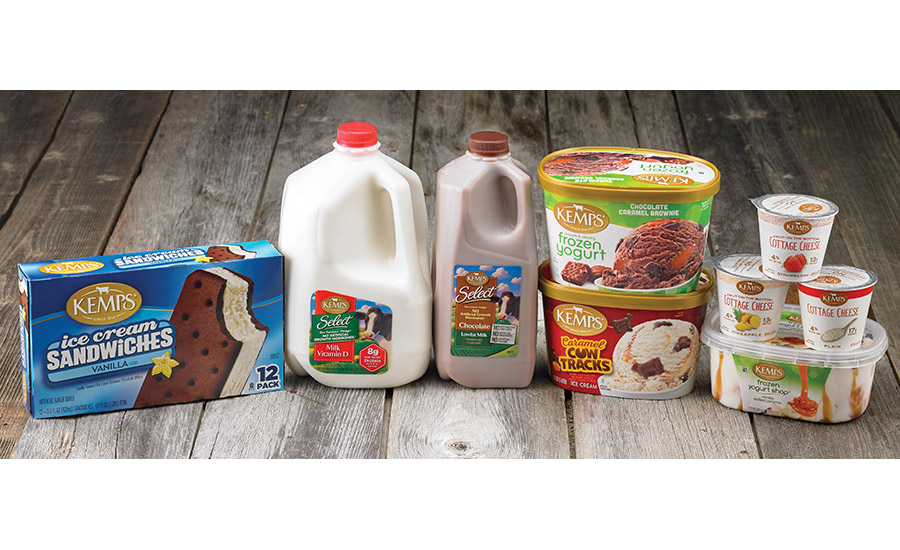


In addition to addressing white space opportunities, DFA’s product innovation efforts include a focus on new product formats and refreshes to the look of legacy brands.
“We’re also in business for the long term,” Panko stressed. “Our farmers are in business for the long term. And we operate in a global landscape; we don’t want to make short-term decisions.”
And DFA’s partnerships aren’t limited to other dairy companies and its farmer owners. Tilley and Panko both lead divisions that partner with customers, too, Massey pointed out.
“A key focus for us is to make sure that we have relevance with our customers,” Panko added. “We’ve actually reallocated a lot of our cost structure outside of a straight sales organization and redeployed it into consumer insights and customer development.”
And DFA’s retail customers are leveraging DFA’s learnings to improve the way they merchandise dairy products in their stores. The dairy processor has developed a couple of different systems to help here, he added, including a shoppable pallet. The pallet allows conventional gallons of milk to be stacked on top of each other, with thin plastic sheets separating each layer. DFA’s version also offers sustainability benefits.
“Our system utilizes a 70-gram jug, where previous solutions used jugs in the 85- to 90-gram range,” Panko said. “It took a lot of engineering and investment on our part. We’re continuing to look at new technology to lessen the usage of resin, to increase sustainability.”
Other projects have resulted in unique dairy offerings for consumer brand customers, Tilley noted.
“DFA has the core competency, the core expertise of dairy and dairy science,” he said. “So we’re able to take that technology and produce products for customers that capitalize on that.”
Dedicated to product innovation
DFA’s investment in facilities and partnerships goes hand-in-hand with its investment in new product innovation.
“At DFA, innovation is one of our core values,” Massey explained. “And while our commercial division employees have long focused on product innovation, in recent years we’ve made a concerted effort to create a culture of innovation here — to push ourselves to try new things, to make us more efficient, more relevant with consumers, and also really more successful.”
Case in point: Through an initiative with Dairy Management Inc., DFA recently created a line of enhanced dairy beverages. Marketed under the Live Real Farms brand, the products combine lactose-free milk and milk protein with fruit juice and ingredients such as green tea extract and vitamins. The lactose-free, gluten-free and fat-free products boast 12 grams of dairy protein per serving.
DFA saw the line as a white space opportunity, Massey said.
“We were willing to take risks to test it for the industry,” she added.
Panko said his division is now backing the line’s commercial launch with investment.
“We’re not looking to make money,” he said. “We’re looking longer term, which is maybe a little bit different than we looked at things in the past.”
It helps, of course, that DFA’s CEO has been — and continues to be — a catalyst for innovation inside DFA, Tilley said.
“I’ve heard Rick characterize innovation as rethinking what you already know, approaching the industry with insight, with an understanding both internally and externally to pursue these opportunities,” he said.

DFA doesn’t want to make shortterm decisions, noted Pat Panko, senior vice president and chief operating officer, fluid milk and ice cream.

Doug Glade, executive vice president of commercial operations, said DFA’s planned office in Singapore is “an exciting milestone” for the company.
Another new launch, the Sports Shake Sportsman protein shake line, leverages DFA’s Sports Shake legacy brand. But, as Tilley explained, DFA used consumer insights and industry research to pursue a different consumer base from that of the main legacy brand: the avid outdoorsmen.
“In pursuing that consumer base, we spent significant monies to build the brand and will continue to spend significant monies in and around that brand,” he said. “And we are having success.”
DFA’s newly acquired extended shelf life dairy processing facility, Cumberland Dairy in New Jersey, also will be conducive to new product innovation going forward. Panko said the company will be focusing on the cultured space here.
“One example is single-serve cottage cheese,” he noted. “It’s really on trend with consumers because of the [positive] attributes of cottage cheese.”
Innovation isn’t limited to new brands, however. DFA’s legacy brands, including Kemps, Borden, La Vaquita, Keller’s Creamery and many more, get their fair share of new products and continued investment, Panko said.
“We recently had to freshen up the brands to make them more relevant to today’s consumers,” Glade said. “And to continue to reinforce that the reason you ought to prefer DFA brands is we’re farmer owned — communicating that great aspect of our great-tasting, high-quality products to consumers.”
Going global
DFA continues to go after growth opportunities for its commercial businesses — not for the sake of growth, but to better meet the needs of the marketplace, Glade said. And that marketplace is increasingly a global one.
He pointed to Southeast Asia and China as two areas of particular interest, thanks to rising demand for dairy protein.
“That really creates a nice opportunity for the high quality of U.S. dairy to meet some of those marketplace needs,” Glade said. “We’re recognizing that we need to make investments outside the U.S. for us to really understand those markets.”
To aid in its efforts overseas, DFA will be opening its first office outside of the United States in 2018. It will be located in Singapore.
“We’ll have a team of people there that can really firsthand better partner with customers there, better understand consumer preferences across Southeast Asia and China,” Glade said. “That’s an exciting milestone for DFA. We’re really looking to again deliver value to the marketplace and deliver value back to our farmer owners by increasing demand for U.S. dairy.”
A sustainability standout
Social responsibility is important to DFA, too, and sustainability initiatives play a crucial role here. But such initiatives can pose a challenge to a continually growing organization, noted David Darr, DFA’s president, farm services, and vice president, sustainability and member services.
Still, the dairy processor strives to achieve sustainability-minded improvements wherever it can. One major emphasis, Darr said, is on water usage reductions in its plants.
“We look at how to use water more efficiently for cleaning purposes, for rinsing purposes,” he said.

Partnerships aimed at enhancing sustainability at the farm level are a priority, said David Darr, DFA’s president, farm services, and vice president, sustainability and member services.

President and CEO Rick Smith said DFA employees continue to be inspired by the cooperative’s family farmers — and their authenticity and commitment to a long-term relationship.
Leak minimization is another big focus. Measuring and evaluating its facilities for air leaks through air compressor systems allows DFA to reap energy savings.
“All of our commercial divisions have continuous improvement teams that are focused, from both an operational side and a financial side, on how we look for incremental ways to get better in what we do,” Darr noted. “A big part of that comes down to sustainability, use of resources and just trying to get a little bit better tomorrow than what we were today.”
Partnerships aimed at enhancing sustainability at the farm level also are a priority. For example, back in April, DFA entered a partnership with Wellesley, Mass.-based Vanguard Renewables to bring anaerobic digestion technology to more of its farmer owners’ dairies across the country. And in September, the cooperative teamed up with Third Sun Solar, Athens, Ohio, to bring solar panel technology to more DFA member farms.
“We have a division of DFA that’s just focused on how we help members at the farm level,” Darr explained. “And when they see opportunities around energy or something else, they’re more frequently coming to us to help them evaluate those opportunities and what could work on their operations.”
In 2018, DFA will be working with the Innovation Center for U.S. Dairy on a stewardship and sustainability framework that provides a set of dairy industry-developed metrics, Darr said.
“That’s a resource that we helped develop,” he said, “and are going to better incorporate and adopt within our facilities to give us more sound metrics that can help us with goals and quantifying reductions as we look ahead.”
Always a leader
In line with its mission to deliver value to farmer owners and the marketplace, DFA also takes a leadership role within the dairy industry. Certain farmer members, for example, have served as chair of the U.S. Dairy Export Council, while the company’s current farmer chairman, Randy Mooney, is chair of the National Milk Producers Federation’s board of directors, Smith noted.
In addition, DFA executives have held leadership positions in many national dairy associations and organizations over the years. The cooperative’s leadership role even extends into global territory — Smith is just ending his term as chairman of the Global Dairy Platform, which leads the development of a collaborative, unified approach on common industry issues.
Smith maintains that DFA must take a leadership stance, given its size and structure.
“We’re the largest seller of milk in the world,” he said. “We are invested in more factories in the United States than anybody else. We’re owned by farmers, but we’re the largest commercial player, depending on how you measure it. So we don’t simply have a leadership role; we have a leadership responsibility.”
That said, DFA recognizes that other companies within the dairy space also play a critical role in leading the industry.
“Sometimes we need to be cognizant that us being in the forefront isn’t the best thing,” Smith said. “So we’ve got to dial it back a bit and let others have their roles, too.”
Going forward, don’t expect DFA to slow down when it comes to industry leadership, as well as investments in infrastructure, partnerships, product innovation and employees.
But in doing so, the cooperative can be counted on to remember — and celebrate — what makes it so wonderfully unique: its dairy farmer owners. DFA employees, Smith said, continue to be inspired by these family farmers — and their authenticity and commitment to a long-term relationship.
“If you’re thinking about passing a business on to children and grandchildren, you take a long-term view of things; you have a perspective that’s different,” he added. “The ups and downs, the volatility that’s in the business, the bumps in the road, the setbacks — if you’re thinking 20 and 40 years out, those are just speed bumps.”
Cover, headquarters and candid executive photos by Vito Palmisano
Looking for a reprint of this article?
From high-res PDFs to custom plaques, order your copy today!







